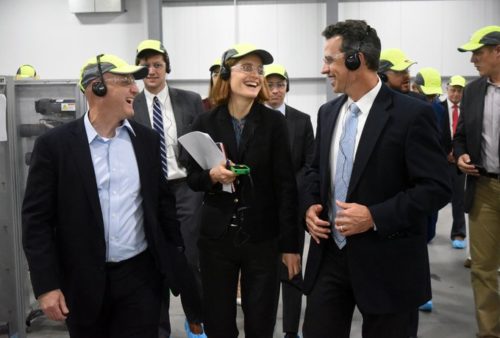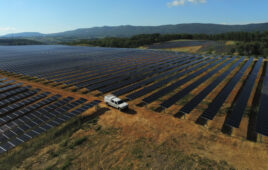Solar contractors are on a time crunch to fit as many installations into 2019 as they can, because in 2020 the solar Investment Tax Credit (ITC) starts to lose its effectiveness.
The ITC is a federal tax subsidy that, in its current capacity, gives solar system owners a 30% return on a solar project’s total tax liability in any market segment. In 2020 the ITC is slated to drop to 26%, 22% in 2021 and in 2022 it will decrease to a 10% subsidy for commercial and utility markets, and zero for residential, indefinitely.
That is, unless, the renewables subsidy receives another extension.
An economic driver

Rep. Joe Wilson (R-SC) visits a Southern Current solar installation. SEIA has encouraged its members to invite lawmakers to array sites to tout solar and the ITC’s effectiveness.
The Solar Energy Industry Association (SEIA) is deep in the throes of advocating for an ITC extension once again. Since May, SEIA has led a multi-faceted lobbying effort, garnering support from hundreds of industry members in and out of solar as well as public officials to back two bills proposing a five-year extension to the renewables subsidy.
“We’re trying to get it done this year,” said Dan Whitten, VP of public affairs at SEIA. “Failure to do anything on the ITC would be a missed opportunity to do something meaningful. The solar industry is still going to grow, but in order to really take off and make a meaningful difference in terms of greenhouse gas emissions, passing the ITC is the first step.”
The industry group’s advocacy efforts have focused on touting the economic benefits of the ITC, appealing to legislators on both sides of the aisle. Since its enactment, the ITC has helped create $140 billion in solar investments in an industry that now employs 242,000 people in the United States.
SEIA has taken a grassroots approach to advocating for the ITC’s extension. The group works with its membership to bring lawmakers to solar sites or company headquarters in their districts. It also invites solar industry members to lobby days in Washington, D.C., where they speak to legislators about the economic potential of solar and the ITC specifically.
SEIA has even made a script to help advocates make calls to Congresspeople in support of the ITC.
“The key is that people actually engage — that people do something because just like in anything, in advocacy, if you do nothing, it’s going to be hard to justify when they complain if the ITC expires on them,” Whitten said. “We need support. We’re leading this effort. We’re putting everything we have into it, but we need the industry to be loud about the need for this or the value of an extension to the investment tax credit.”
In conjunction with SEIA, Wood Mackenzie released the report “Impact of Solar Investment Tax Credit Extension” that predicts the ITC’s economic potential if it were active another 10 years. The report estimates that if the ITC were extended from 2020 to 2030, an additional 82 GW of solar could be installed in the country. The loss of the subsidy would mean a loss of about 5 to 12 GW of solar annually, according to the report.
“There are billions and billions of dollars being spent to keep uneconomic plants operating, and it’s the ultimate irony to have people who years ago were saying we shouldn’t do renewables, because we should let the market decide winners and losers,” Whitten said. “Now that the market is deciding that wind and solar are the winners, the other side who was fighting for the market to rule the day are now saying, ‘Well, you can’t just go with markets. We’ve got to keep our uneconomic plants running,’ and the fact is that it’s not proven that tens of billions of dollars in subsidies for those plants is in the public interest in any respect.
“From our perspective, it’s not a matter of absolute need, it’s a matter of stimulating private investment in renewable energy,” he continued. “That is clearly in the public good.”
Hope for the ITC in the capital
Legislators in the House and Senate concurrently introduced two bills titled the Renewable Energy Extension Act in July. The bills both ask for another five-year extension to sections of the internal revenue code that established the renewable energy subsidy.
“Protecting our environment is good for our health and economy,” said Sen. Catherine Cortez Masto (D-NV) in a press statement. “These tax incentives help us achieve these goals by increasing commercial and residential solar use, reducing carbon emissions and creating good-paying jobs.”

Rep. Tom Graves (R-GA) visits Hanwha Q CELLS’ Dalton, Georgia, factory.
Cortez Masto introduced SB 2289 to Senate, with support from 15 democratic senators, including presidential candidates Cory Booker (D-NJ) and Kamala Harris (D-CA). In the House, HB 3961 has bipartisan support, brought to the floor by representatives Mike Thompson (D-CA), Paul Cook (R-CA) and Brian Fitzpatrick (R-PA).
“Clean energy presents an enormous opportunity to grow our economy, reduce carbon emissions and bolster our national security,” said Fitzpatrick in a press release. “Entrepreneurship in clean energy must be incentivized for these reasons, and I strongly support enhanced investment in the clean energy sector to promote American prosperity.”
Prior to the bills being introduced, SEIA gathered signatures from approximately 1,000 companies and sent a letter to Congress supporting an extension of the ITC.
“We’re going to continue to do that. We’re looking for allies across the economy to support the extension of the ITC, so [we’re] building coalitions and getting our members active,” Whitten said.
The act is awaiting action in the House and Senate after both bills were referred to committees in July.
History of the ITC
The ITC was created in the Energy Policy Act of 2005, or, as Whitten called it, the last comprehensive energy legislation in the United States.
“It was basically [enacted] against a backdrop of growing awareness of climate change and a feeling that renewables could make a difference,” he said.
Two sections in the Energy Policy Act (25D and 48) established a tax credit for residential and commercial customers; and they’re the subject of extension in the renewable energy acts in the House and Senate.
The ITC went into effect in 2006 and was renewed in 2007 and then in 2008, staying active until 2016. It was originally renewed annually, but when the U.S. economy collapsed in 2008, a primary goal for legislators was jobs creation. Solar could create jobs if the ITC was permanent for a while, said Tony Clifford, chief development officer of Standard Solar and executive committee member with SEIA.
“When it really had an impact was when it was extended at the end of 2008, because you could do planning and weren’t saying, ‘I have to get this done this year because the ITC is going to be gone in a year,’” he said.
The ITC was renewed once more in 2015 to run from 2016 and begin a sunset at the end of 2019. Solar projects started in 2019 are still eligible for the full 30% subsidy from the ITC if they’re completed by the end of 2024.
If the ITC isn’t extended, Clifford still sees the solar industry heading in an upward trajectory, “just at a different slope.” His greatest concern if it doesn’t pass is the subsidy going to zero for the residential market.
“We need really active, aggressive advocacy from people who care about solar energy, and people who profit from solar energy,” SEIA’s Whitten said. “We need support, and I can’t emphasize that enough.”




” Whitten said. “Now that the market is deciding that wind and solar are the winners, the other side who was fighting for the market to rule the day are now saying, ‘Well, you can’t just go with markets. We’ve got to keep our uneconomic plants running,’ and the fact is that it’s not proven that tens of billions of dollars in subsidies for those plants is in the public interest in any respect.”
Remember the cartoon of finding Dory? The seagulls would see something they wanted to eat and say….mine!….mine!…..mine! mine! mine!…. Reminds of me of these ‘great’ minds running the electric companies now. Just think, you too could go to business school, get into debt to become a seagull too. Oh, the ‘humanity’ of it all…..
“Two sections in the Energy Policy Act (25D and 48) established a tax credit for residential and commercial customers; and they’re the subject of extension in the renewable energy acts in the House and Senate.”
Give people a chance to get some of their tax money back and a solar PV system with energy storage.